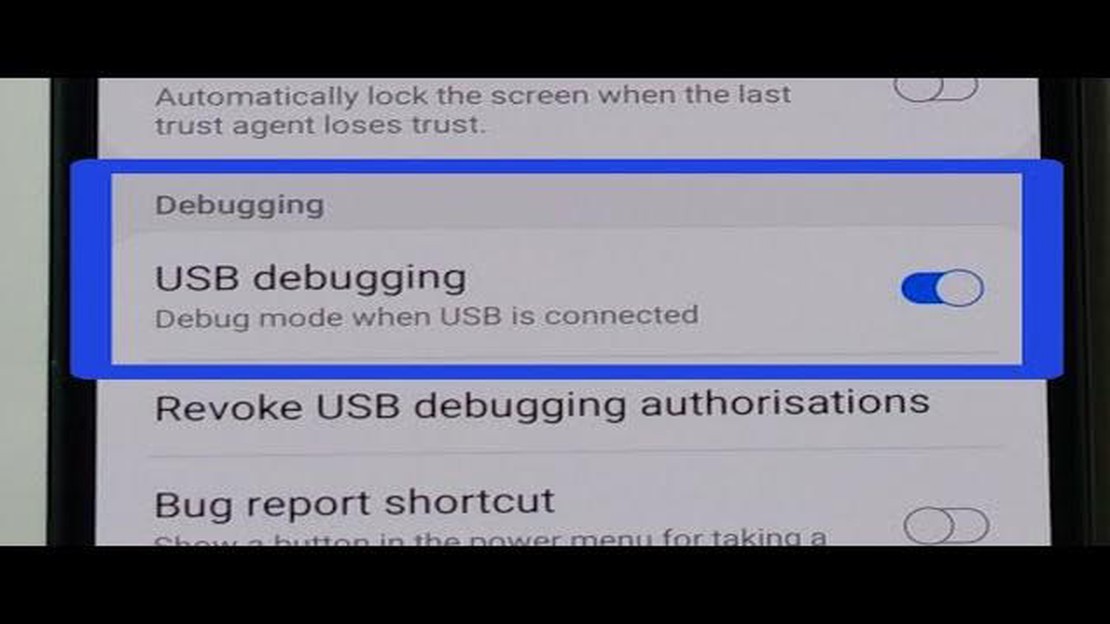New in Android 12: fast implementation of new emoji will delight users
The innovation in android 12 will please many users. new emoji can be implemented faster… Android 12, the new version of the popular operating system …
Read Article
USB debugging is an important feature for Android developers and advanced users as it allows you to connect your Samsung Galaxy A50 to a computer and access the device’s internal storage, install custom ROMs, and perform various other tasks. However, USB debugging is disabled by default for security reasons.
If you want to enable USB debugging on your Samsung Galaxy A50, the process is quite simple. Follow the steps below:
Step 1: Go to the “Settings” menu on your Samsung Galaxy A50.
Step 2: Scroll down and tap on “About phone”.
Step 3: Look for the “Software information” option and tap on it.
Step 4: Locate the “Build number” and tap on it seven times to enable developer options.
Step 5: Once developer options are enabled, go back to the main “Settings” menu and tap on “Developer options”.
Step 6: Scroll down and look for the “USB debugging” option. Tap on the toggle switch next to it to enable USB debugging.
That’s it! You have successfully enabled USB debugging on your Samsung Galaxy A50. You can now connect your device to a computer and access its files, transfer data, and perform various tasks that require USB debugging.
USB debugging is a feature on Android devices that allows developers to communicate with the device via a USB connection. Enabling USB debugging is necessary when you want to transfer files, install custom ROMs, or access certain advanced features on your Samsung Galaxy A50.
Here’s how you can enable USB debugging on your Samsung Galaxy A50:
Read Also: Top 10 tools for saving Facebook stories: how to save your favorite moments
Once enabled, you can connect your Samsung Galaxy A50 to your computer using a USB cable and transfer files, debug apps, or perform other developer-related tasks.
Note that USB debugging should only be enabled when necessary, as it can pose a security risk if enabled all the time. It is recommended to disable USB debugging when you are not using it.
Read Also: How to Customize Font on Samsung Galaxy Z Flip 4 - Step-by-Step Guide
That’s it! You have successfully enabled USB debugging on your Samsung Galaxy A50. Now you can make use of the advanced developer options and perform various tasks that require USB debugging.
If you want to enable USB Debugging mode on your Samsung Galaxy A50, follow these simple steps:
That’s it! You have successfully enabled USB Debugging mode on your Samsung Galaxy A50. Remember to disable USB Debugging mode when you are done using it to ensure the security of your device.
USB debugging is a developer option on Android devices that allows you to establish a connection between your phone and a computer via USB. It enables advanced features such as transferring files, debugging apps, and controlling your device from your computer.
You need to enable USB debugging on your Samsung Galaxy A50 if you want to transfer files between your phone and computer, debug apps, or perform advanced tasks using tools like ADB (Android Debug Bridge).
To enable USB debugging on your Samsung Galaxy A50, go to the Settings app, scroll down and tap on ‘Developer options’. Then, toggle on the ‘USB debugging’ option and confirm your action.
To access the ‘Developer options’ on your Samsung Galaxy A50, go to the Settings app, scroll down to the bottom, and tap on ‘About phone’. Then, scroll down again and tap on the ‘Software information’ option. Finally, tap on ‘Build number’ seven times to unlock the ‘Developer options’.
Enabling USB debugging on your Samsung Galaxy A50 doesn’t pose any direct risks. However, it is important to keep in mind that USB debugging allows for deep access to your device, so be cautious when connecting it to unknown computers or granting debugging permissions to unknown apps.
USB debugging is a mode that allows your phone to establish a direct connection with a computer and transfer data. Enabling USB debugging on your Samsung Galaxy A50 is necessary if you want to transfer files between your phone and computer, or if you want to perform advanced tasks such as rooting your device or debugging apps.
The innovation in android 12 will please many users. new emoji can be implemented faster… Android 12, the new version of the popular operating system …
Read ArticleHow To Fix Call Of Duty Warzone Keeps Crashing On PS5 (Updated 2023) Call of Duty Warzone has become one of the most popular battle royale games on …
Read ArticleHow to fix xbox controller blinking or flashing The Xbox controller is one of the most popular accessories for Microsoft game consoles. However, just …
Read ArticleHow to Fix WWE 2K23 Unable to Communicate with the Server Are you experiencing the “Unable to Communicate with the Server” issue while trying to play …
Read ArticleFitbit Versa Syncing Issue: Connection with Android device keeps dropping If you own a Fitbit Versa and you’re experiencing syncing issues with your …
Read ArticleHow To Fix Roku TV Stuck On Loading Screen Issue If you have a Roku TV and are experiencing the frustrating problem of it being stuck on the loading …
Read Article